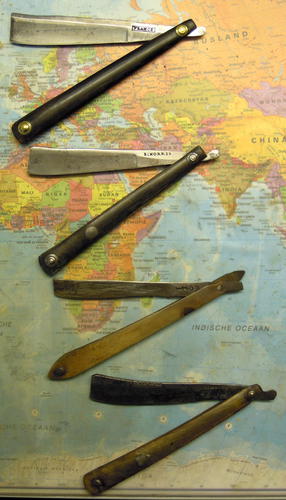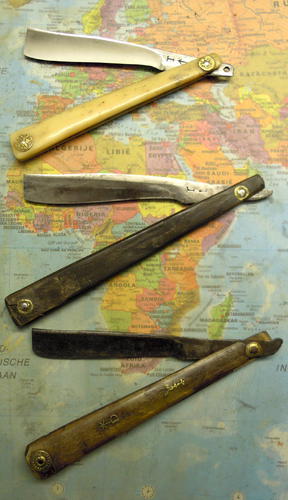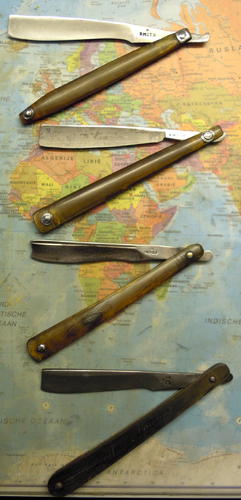Results 1 to 10 of 529
Thread: That 1700's Show
Hybrid View
-
04-20-2016, 01:44 PM #1Member

- Join Date
- Oct 2015
- Location
- France
- Posts
- 37
Thanked: 16
Martin (and others), would you consider the letter blocks an indication of the age ? The more primitive the older ? Or does it only reflect the quality of the stamps used ?
-
04-20-2016, 02:14 PM #2Historically Inquisitive



- Join Date
- Aug 2011
- Location
- Upstate New York
- Posts
- 5,782
- Blog Entries
- 1
Thanked: 4249
-
04-20-2016, 02:18 PM #3

Thankx for the pictures!
Could indeed be R Heart SPAIN!
Indeed, Zak also mentioned that the mark stamp in Sketchley's Directory 1774 could be wrong
Also a bit more information that Zak gave (Thank you Zak!), if you don't have this already:
http://straightrazorpalace.com/razor...d-shavers.html (p. 58, post #580)
-
-
04-20-2016, 02:48 PM #4Member

- Join Date
- Oct 2015
- Location
- France
- Posts
- 37
Thanked: 16
Thank you Fikira !
I read that post from Zak but totally forgot about it !
About edge length, may I ask those who own razors from that time if they meet mine ? I've got two razors little younger (probably around 1790-1800 - one Clark and Hall and one Birks - both Cast steel) that are shorter (3" 3/16 and 3" long). Zak, If you read me, I'd like to have your measurements.
How do they shave by the way ? Been told they were much softer than (let's say) 1820's Sheffield. Is it possible it is made of cast steel (without mentioning it) or is it quite early for that time ?
-
The Following User Says Thank You to inoe For This Useful Post:
Fikira (04-20-2016)
-
04-20-2016, 04:55 PM #5
-
04-22-2016, 02:32 PM #6

Here we go:
So, in comparison with your 15/16' and 3' 11/32 long edge (8.5 cm), here are some of mine:

From above to below:
"France" (1780-1790): 3 2/8' (8,25cm)
"S:Norris" (1770-1790): 3 1/16' (7,78cm)
Unknown: 3 1/8' (7,9cm)
"Limrick" (John Hall, Sharrow Moor, Sheffield, around 1790-1795): 2 15/16' (7,46cm)

From above to below:
Unknown: 3' (7,62cm)
Unknown: 3 2/8' (8,25cm)
"*P" (John Fox) (I guess 1760-1770): 3' (7,62cm)

An extra picture of the John Fox (this razor is already known by you )
)
http://straightrazorpalace.com/razor...or-inside.html
http://straightrazorpalace.com/razor...king-info.html

From above to below:
"+SMITH" (1760-1770): 3 5/8' (9,2cm)
"+SMITH" (1760-1770, restored, grounded, probably in the 19th century): 3 9/16' (9cm)
(both "+SMITH"'s are also recognizable for you
http://straightrazorpalace.com/razor...or-inside.html
http://straightrazorpalace.com/razor...rge-smith.html)
"crown WOLF" (around 1790?): 3' (7,62cm)
"+GB" (around 1790?): 3 1/8' (7,9cm)
So, my oldest ones (2 "+SMITH"'s, 1760-1770) do have the longest edge (3 5/8' (9,2cm) & 3 9/16' (9cm)),
BUT the "*P" (John Fox), of which I guess is from 1760-1770 as well, has a shorter edge of 3' (7,62cm)

Last edited by Fikira; 04-22-2016 at 02:37 PM.
-
-
04-22-2016, 02:38 PM #7

Fikira - I'm curios as to the GB with the Maltese cross we frequently see, the ones more in the "modern" style, and most dates associated with them are 1790-1810 - is that accurate as far as you know?
-
04-22-2016, 02:47 PM #8

Well, the data runs from 1774 (Broomhead, Wilkinson & Brittain), 1784 (Brittain, Wilkinson, Brownell) until way beyond 1820 actually, even beyond 1860, when the mark was passed by Brownell through Stacey, Peace & Co, and later the mark was acquired by Gem...
Not to mention the famous +GB with anchor mark...


 1401Likes
1401Likes LinkBack URL
LinkBack URL About LinkBacks
About LinkBacks






 Reply With Quote
Reply With Quote


